 |
||
|
||
| ||
The A500 is a power amplifier for home studios and Hi-Fi systems. This amplifier has large handy volume controls for each channel to make it convenient to use in a Hi-Fi system. This amplifier is very quiet compared to other professional amplifiers, as it does not use active cooling and contains a toroidal transformer.  The amplifier is equipped with all possible inputs - RCA, TRS, and XRL. The speaker outputs give you a choice between professional 'touch-proof' binding posts and 1/4' TS connectors.  According to the manufacturer, the amplifier is based on ultra-reliable Toshiba transistors. The servo mechanism and preamp are based on the JRC4580 opamp. The manufacturer claims that the amplifier offers low distortions (about 0.01%) and the output power of 230 W for 4 Ohm and 160 W for 8 Ohm. In bridged mode - 500 W for 8 Ohm.  Objective measurements of the Behringer A500 amplifier
Objective measurements were taken in compliance with our procedure for testing amplifiers. 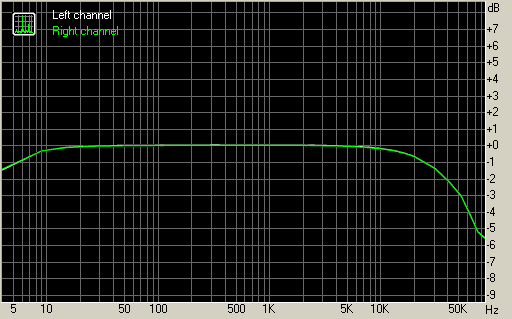 Frequency response characteristic of the A500 The amplifier demonstrates a good frequency response characteristic. Maximum power level is determined only before the overload condition.
 Maximum power level is twice as low as the value in the specifications, but it falls within 0.01%. This percentage cannot characterize the sound quality, which in its turn depends on the distribution of n-tuple harmonics. Distortions versus power, frequency, and loadHarmonics of the 10 kHz test signal act as a noise shelf below 10 kHz. Harmonics of the 100 Hz test signal are below the noise threshold.  3.9 Ohm load - near the maximum power threshold  3.9 Ohm load - average power level 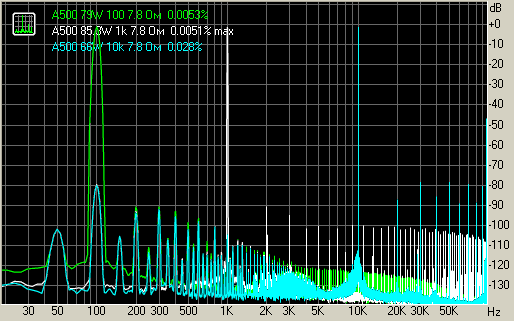 7.8 Ohm - near the maximum power threshold  7.8 Ohm - average power level As you can see, the harmonics level is a tad lower at higher power capacity. The level of distortions in the A500 rises to high frequencies, which is typical of many amplifiers. The harmonic spectrum is unfavourable, because harmonics subside insignificantly. According to psychoacoustics, n-tuple harmonics near the fundamental tone are camouflaged better. Human ears discern a lot of ultraharmonics better. A situation with significantly subsiding harmonics, even ultraharmonics, would have been preferable. However, we should take into account the level of harmonics as well. In our case, we can hear harmonics only in the HF range. Distortions versus gain 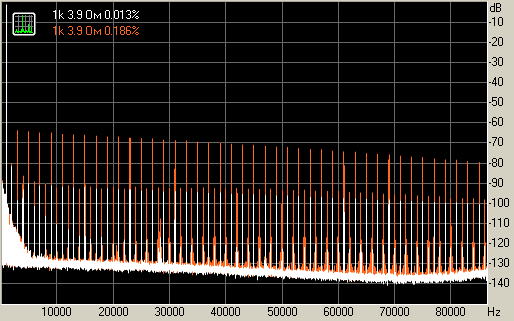 When you reduce gain with the volume control, distortions generally grow for all reference frequencies (100 Hz, 1 kHz, and 10 kHz) by 5~20 dB. The greatest distortions fall to 80% of maximum gain. This amplifier would have been a very good choice for its class, but for this problem.  The high distortion level suggests poor tuning of the amplifier. There are three calibration resistors in the amplifier, one of them allowed to reduce distortions. The volume control shows the best effect from reducing distortions by adjusting the calibration resistor. The problematic zone got smaller. The character of distortions also improved - higher harmonics in the spectrum subside at a higher angle. The maximum output power remains at the same level, the third harmonic got a tad higher. At the same time, ultraharmonics got lower.  Subjective impressionsThe amplifier offers the best audio quality, when its gain is set to maximum. In this mode harmonics are audible only in the HF range. The negative moment here is that the volume should be controlled with a sound card or with an external mixer. When balanced and non-balanced signals were fed to the input, the maximum power level with the highest gain that did not overload the amplifier was reached with a -10~12 dB signal (it did not overload the input, there were no problems with lower gain levels). We had to reduce the signal to -50~60 dB for low-profile audio. When a CD-Audio signal is scaled down through a 24-bit digital mixer, there is a margin of 48 dB, 96 dB for a 32-bit mixer. However, as a signal is scaled down, the noise shelf goes up. When a signal is scaled down to 40 dB at maximum gain, we can clearly hear interferences from devices around. Moreover, we can hear rustling from the LEDs that indicate the output signal level. Thus, a user has to choose between distortions in the MF-HF range with lower gain and maximum gain with interferences. Having adjusted the calibration resistor, we have a gripe only with the 60-90% volume control zone. The audio quality is good in other positions. Subjectively, it does not differ much from the maximum gain mode. Perhaps, other batches of this amplifier are tuned better. Even though this amplifier is intended for home-projects and Hi-Fi systems, one of its primary applications can be servicing concert speakers, where an amplifier has to work with high output power. In this case, an input signal should be reduced by 10-15 dB in a mixer before the amplifier. So your amplifier will not act as a bottleneck in the audio path. I doubt that you can use this amplifier in a small home-project studio. It provides good audio quality only with high output power, which will be excessive for most passive speakers. And if you adjust the calibration resistor to obtain higher quality at a low output power level, you will automatically lose your warranty. Nevertheless, this resistor being adjusted, the amplifier demonstrates adequate audio quality. Should we actually be so concerned with ultraharmonics at -70 dB, if audio volume is adjusted with the stock controls? The signal spectrum looks as if the signal is clipped, and it sounds like it is. Hence, it will be much more difficult to work with limiters, and it will be subjectively hard to control overloads. We suggest listening to a music fragment in maximum gain mode and in a mode with maximum harmonics, when a signal level is reduced with the stock volume control to evaluate minimum and maximum quality of the amplifier. The recording is done via the E-MU1616m with the 3.9 Ohm load.  maximum gain
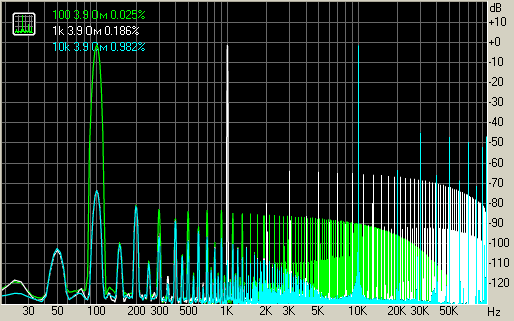 maximum harmonics level
You can look up distortion spectrums of active speakers in our Sound reviews. There is an opinion that speakers themselves generate much more distortions than amplifiers, and that amplifier distortions won't be audible. Most active monitors lack ultraharmonics of the level the A500 demonstrates. In its turn, it discredits the idea that active monitors use cheap low quality chips for cars. Active speakers may be a good choice for a maladjusted A500.  Spectrum of a signal from the Fostex fe 103 erev 2 speaker. Harmonics following the third one are harmonics of the amplifier with reduced gain To hear amplifier's distortions in the problem mode, you shouldn't necessarily plug it to high quality speakers - distortions are audible even with $100~300 speakers. Moreover, the A500 has got a lot of positive reviews. There are two reasons:
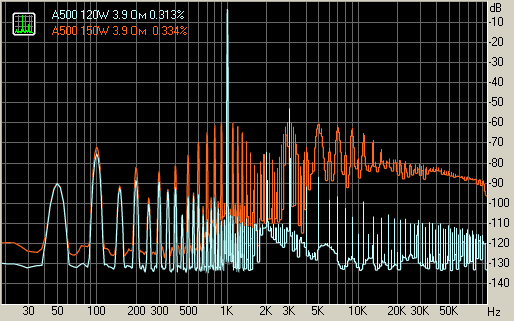 The output spectrum of the tuned A500 - the second and third harmonics are higher just as the THD You can see well that the THD is little different, while distortions differ much, visually and by ear. If you don't know what spectrum represents a signal or you don't audition the amplifier at this power level, you can write that the A500 outputs ~250 W at 1% and 320 W at 10%. But everything above 0.313% is low quality audio.  In this case the amplifier is overloaded, which is indicated by its LEDs.  Subjectively, the audio quality in the overloaded mode differs greatly. That's why no measurements are taken in this mode - there is no point. We are interested only in a non-overloaded mode. In fact you can measure PMPO to be 1000 W and higher and to be proud of it, as it's done with cheap devices. In audiophile domain, better sound quality is produced by more expensive devices or devices based on scientific theories (sort of the effect of moon phases on the speed of electrons inside a cable). In case of budget studio amplifiers it's a toroidal transformer and double mono without timbre controls. What you hear is irrelevant. It's your brains that do the evaluation. Ears are trusted in studios more, so audio quality flaws are much more noticeable here. Specifications of professional amplifiers usually publish their power at 0.1% and 1% THD. Spectrums are rarely published. The most important aspect of objective measurements is a balance between informativity and adequacy of results. Requirements to objective measurements should be elaborated here. One of the problems here is impossibility to automate the process, a tester has to adjust volume manually. ConclusionsThe Behringer A500 may please DJs and musicians who use concert speakers that require high output power. In this case, the audio quality will be high. The second option is to use the amplifier with passive main mid zone monitors. I doubt that it can be used in home-project studios and Hi-Fi systems. This device has a high amplification factor, and it provides high audio quality at maximum gain. Adjusting gain degrades audio quality. It even gets low at certain gain values. The problem can be partially solved by manual adjustment of the on-board calibration resistor. If you want to use maximum gain of the amplifier for the highest audio quality, you will have to scale down the input signal, which will result in the reproduction of interferences from devices around and built-in LEDs. Thus, this device amplifies signals very well, but the problem is in its bad gain control, which narrows down the application domain of the A500. Write a comment below. No registration needed!
|
Platform · Video · Multimedia · Mobile · Other || About us & Privacy policy · Twitter · Facebook Copyright © Byrds Research & Publishing, Ltd., 1997–2011. All rights reserved. |